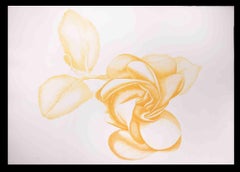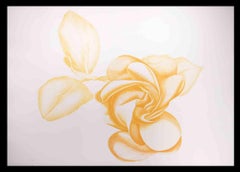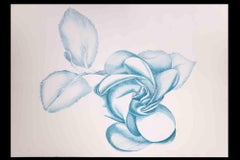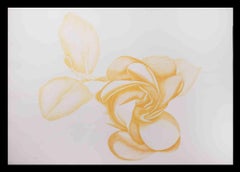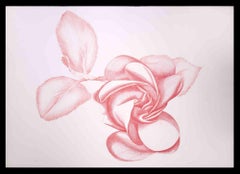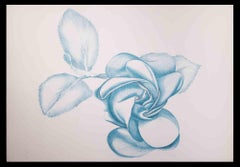Flower Figurative Prints
to
90
347
99
180
106
45
Overall Width
to
Overall Height
to
305
264
23
17
14
13
11
7
6
4
4
2
1
45
18
16
15
15
35
217
368
157
2
1
18
5
10
14
32
105
55
32
29
514
222
36
11,028
26,728
14,637
10,484
8,986
7,657
6,977
4,522
4,098
2,366
2,026
1,921
1,865
1,702
1,466
1,463
1,462
1,457
1,277
1,220
375
111
96
89
44
40
514
433
239
Art Subject: Flower
Yellow Rose - Etching by Giacomo Porzano - 1972
Located in Roma, IT
Yellow Rose is an original modern artowork realized by the Italian artist Giacomo Porzano (1925-2006) in 1972.
Mixed colored etching.
Hand-signed and dated on the lower right. Edit...
Category
1970s Contemporary Figurative Prints
Materials
Etching
Yellow Rose - Etching by Giacomo Porzano - 1972
Located in Roma, IT
Yellow Rose is an original modern artwork realized by the Italian artist Giacomo Porzano (1925-2006) in 1972
Mixed colored etching.
Hand-signed and dated on the lower right. Editio...
Category
1970s Contemporary Figurative Prints
Materials
Etching
Blue Rose - Etching by Giacomo Porzano - 1970s
Located in Roma, IT
Blue Rose is an original contemporary artwork realized by Giacomo Porzano in 1970s.
Colored etching
Hand-signed on the lower right.
Numbered on the lower left.
Edition 11/50
Gia...
Category
1970s Contemporary Figurative Prints
Materials
Etching
Yellow Rose - Etching by Giacomo Porzano - 1972
Located in Roma, IT
Yellow Rose is an original modern artwork realized by the Italian artist Giacomo Porzano (1925-2006) in 1972.
Mixed colored etching.
Hand-signed and dated on the lower right. Editi...
Category
1970s Contemporary Figurative Prints
Materials
Etching
Red Rose - Etching by Giacomo Porzano - 1970s
Located in Roma, IT
Red Rose is an original contemporary artwork realized by Giacomo Porzano in 1970s.
Colored etching
Hand-signed on the lower right.
Numbered on the lower left.
Edition 15/50.
...
Category
1970s Contemporary Figurative Prints
Materials
Etching
Blue Rose - Original Etching by Giacomo Porzano - 1970s
Located in Roma, IT
Blue Rose is an original contemporary artwork realized by Giacomo Porzano in 1970s.
Colored etching.
Hand-signed on the lower right.
Numbered on the lower left.
Edition 2/50
Gia...
Category
1970s Contemporary Figurative Prints
Materials
Etching
Red Rose - Original Etching by Giacomo Porzano - 1970s
Located in Roma, IT
Red Rose is an original contemporary artwork realized by Giacomo Porzano in 1970s.
Colored etching
Hand-signed on the lower right.
Numbered on the lower left.
Edition 11/50.
...
Category
1970s Contemporary Figurative Prints
Materials
Etching
Blue Rose - Etching by Giacomo Porzano - 1970s
Located in Roma, IT
Blue Rose is an original contemporary artwork realized by Giacomo Porzano in 1970s.
Colored etching
Hand-signed on the lower right.
Numbered on the lower left.
Edition 3/50
Giac...
Category
1970s Contemporary Figurative Prints
Materials
Etching
Red Rose - Etching by Giacomo Porzano - 1970s
Located in Roma, IT
Red Rose is an original contemporary artwork realized by Giacomo Porzano in 1970s.
Colored etching
Hand-signed on the lower right.
Numbered on the lower left.
Edition 10/50.
...
Category
1970s Contemporary Figurative Prints
Materials
Etching
Yellow Rose - Etching by Giacomo Porzano - 1970s
Located in Roma, IT
Yellow Rose is an original modern artowork realized by the Italian artist Giacomo Porzano (1925-2006) in 1972
Mixed colored etching.
Hand-signed and dated on the lower right. Editi...
Category
1970s Contemporary Figurative Prints
Materials
Etching
Blue Rose - Etching by Giacomo Porzano - 1970s
Located in Roma, IT
Blue Rose is an original contemporary artwork realized by Giacomo Porzano in 1970s.
Colored etching
Hand-signed on the lower right.
Numbered on the lower left.
Edition 12/50
Gia...
Category
1970s Contemporary Figurative Prints
Materials
Etching
Yellow Rose - Etching by Giacomo Porzano - 1970s
Located in Roma, IT
Yellow Rose is an original modern artowork realized by the Italian artist Giacomo Porzano (1925-2006) in 1972.
Mixed colored etching.
Hand-signed and dated on the lower right. Edit...
Category
1970s Contemporary Figurative Prints
Materials
Etching
Red Rose - Etching by Giacomo Porzano - 1970s
Located in Roma, IT
Red Rose is an original contemporary artwork realized by Giacomo Porzano in 1970s.
Colored etching
Hand-signed on the lower right.
Numbered on the lower left.
Edition 8/50.
Gia...
Category
1970s Contemporary Figurative Prints
Materials
Etching
Yellow Rose - Etching by Giacomo Porzano - 1970s
Located in Roma, IT
Yellow Rose is an original modern artowork realized by the Italian artist Giacomo Porzano (1925-2006) in 1972
Mixed colored etching.
Hand-signed and dated on the lower right. Editi...
Category
1970s Contemporary Figurative Prints
Materials
Etching
Black Rose - Original Etching by Giacomo Porzano - 1970s
Located in Roma, IT
Black Rose is an original modern artowork realized by the Italian artist Giacomo Porzano (1925-2006) in 1972.
Black and white etching.
Hand-signed and dated on the lower right.
Nu...
Category
1970s Contemporary Figurative Prints
Materials
Etching
Blue Rose - Etching by Giacomo Porzano - 1970s
Located in Roma, IT
Blue Rose is a contemporary artwork realized by Giacomo Porzano in 1970s.
Colored etching
Hand-signed on the lower right.
Numbered on the lower left.
Edition 14/50
Giacomo Porza...
Category
1970s Contemporary Figurative Prints
Materials
Etching
Red Rose - Original Etching by Giacomo Porzano - 1970s
Located in Roma, IT
Red Rose is an original contemporary artwork realized by Giacomo Porzano in 1970s.
Colored etching
Hand-signed on the lower right.
Numbered on the lower left.
Edition 14/50.
...
Category
1970s Contemporary Figurative Prints
Materials
Etching
Black Rose - Original Etching by Giacomo Porzano - 1970s
Located in Roma, IT
Black Rose is an original modern artowork realized by the Italian artist Giacomo Porzano (1925-2006) in 1972
Black and white etching.
Hand-signed and dated on the lower right. Edit...
Category
1970s Contemporary Figurative Prints
Materials
Etching
Blue Rose - Original Etching by Giacomo Porzano - 1970s
Located in Roma, IT
Blue Rose is an original contemporary artwork realized by Giacomo Porzano in 1970s.
Colored etching
Hand-signed on the lower right.
Numbered on the lower left.
Edition 44/50
Gia...
Category
1970s Contemporary Figurative Prints
Materials
Etching
Blue Rose - Original Etching by Giacomo Porzano - 1970s
Located in Roma, IT
Blue Rose is an original contemporary artwork realized by Giacomo Porzano in 1970s.
Colored etching
Hand-signed on the lower right.
Numbered on the lower left.
Edition 31/50.
Gi...
Category
1970s Contemporary Figurative Prints
Materials
Etching
Black Rose - Etching by Giacomo Porzano - 1972
Located in Roma, IT
Black Rose is an original modern artwork realized by the Italian artist Giacomo Porzano (1925-2006) in 1972
Black and white etching.
Hand-signed and dated on the lower right.
Numb...
Category
1970s Contemporary Figurative Prints
Materials
Etching
Red Rose - Original Etching by Giacomo Porzano - 1970s
Located in Roma, IT
Red Rose is an original contemporary artwork realized by Giacomo Porzano in 1970s.
Colored etching
Hand-signed on the lower right.
Numbered on the lower left.
Edition 14/50.
Gi...
Category
1970s Contemporary Figurative Prints
Materials
Etching
Black Rose - Original Etching by Giacomo Porzano - 1972
Located in Roma, IT
Black Rose is an original modern artowork realized by the Italian artist Giacomo Porzano (1925-2006) in 1972
Black and white etching.
Hand-signed and dated on the lower right. Edit...
Category
1970s Contemporary Figurative Prints
Materials
Etching
Blue Rose - Etching by Giacomo Porzano - 1970s
Located in Roma, IT
Blue Rose is an original contemporary artwork realized by Giacomo Porzano in 1970s.
Colored etching
Hand-signed on the lower right.
Numbered on the lower left.
Edition 16/50.
Gi...
Category
1970s Contemporary Figurative Prints
Materials
Etching
Blue Rose - Etching by Giacomo Porzano - 1970s
Located in Roma, IT
Blue Rose is an original contemporary artwork realized by Giacomo Porzano in 1970s.
Colored etching
Hand-signed on the lower right.
Numbered on the lower left.
Edition 29/50
Gia...
Category
1970s Contemporary Figurative Prints
Materials
Etching
The Butterfly Flower - Lithograph By Jean Lurçat - Mid-20th Century
By Jean Lurçat
Located in Roma, IT
The Butterfly Flower is an original artwork realized by the french artist Jean Lurçat (1892 Bruyeres - 1966 St.-Paul-de-Vence)
Lithograph print, mid-20th century.
Good conditions...
Category
Mid-20th Century Modern Figurative Prints
Materials
Lithograph
The Winners - Original Woodcut by Abel Faivre - Mid 20th Century
Located in Roma, IT
The Winners is an original wood engraving artwork realized by French painter and illustrator Abel Faivre (Leone, March 30, 1867 – Nizza, August 30, 1945) in the early 20th Century.
...
Category
Mid-20th Century Modern Figurative Prints
Materials
Woodcut
Flowerpot - Original Lithograph by Jovan Vulic - 1988
By Jovan Vulic
Located in Roma, IT
Flowerpot is a beautiful colored lithograph on paper, realized in 1988 by the artist Jovan Vulic (b. 1951).
Hand-signed and numbered in pencil on the lower margin. Edition of 150 ...
Category
1980s Contemporary Figurative Prints
Materials
Lithograph
The Spring - Original Screen Print by Maddalena Striglio - Late 20th century
Located in Roma, IT
The Spring is a very brightly colored serigraph realized by the contemporary Italian artist Maddalena Striglio.
Hand-signed in pencil on the lower right. Numbered on the lower le...
Category
Late 20th Century Contemporary Figurative Prints
Materials
Screen
Pink Blossoms - Lithograph by Martine Goeyens - 2000s
Located in Roma, IT
Pink blossoms is an original colored lithograph realized by the Belgian artist Martine Goeyens.
On the back, the label of the certificate of authenticity by the "Fondazione Di Paol...
Category
Early 2000s Contemporary Figurative Prints
Materials
Lithograph
Starlet Rose - 21st Century Contemporary Photographic Print - B/W Polaroid
By Pia Clodi
Located in Zürich, CH
Shadowed Beauty - 21st Century Contemporary Photographic Print - Black & White Polaroid, Polaroid Original, Shadow Gapped Frame - Photographic Print on Aluminium Dibond - Edition of ...
Category
21st Century and Contemporary Contemporary Figurative Photography
Materials
Carbon Pigment, Polaroid
$1,820 Sale Price
20% Off
Flowerpot - Original Etching by H. Le Bourdelles - 1960s
Located in Roma, IT
Flowerpot is an original artwork realized by French artist Hervé Le Bourdelles (Paris, 1928).
Etching print.
Hand-signed on the lower right in pencil.
O...
Category
1960s Modern Figurative Prints
Materials
Etching
Ode to Manet's Olympia
Located in New Orleans, LA
27 x 36 inches - Edition 1 of 3 with 2 APs
framing is an additional $525.
Shot in New Orleans in 2011, background illustrated by Marco Ventura
Inspired by Manet’s Olympia...
Category
21st Century and Contemporary Contemporary Figurative Photography
Materials
Archival Pigment
Still Life - Vintage Offset Print by Franco Gentilini - 1970s
Located in Roma, IT
Still Life is an original vintage offset print on ivory-colored paper, realized after Franco Gentilini (Italian Painter, 1909-1981), in 1970s.
The state of preservation of the artwo...
Category
1970s Contemporary Figurative Prints
Materials
Paper, Offset
The Sea - Original Lithograph by Sandro Sanna - 1969
By Sandro Sanna
Located in Roma, IT
The Sea is an original lithograph by Sandro Sanna in 1969.
Hand-signed and dated on the lower right.
Edition: 79/100.
In excellent conditions: as good as new.
The artwork represe...
Category
1960s Landscape Prints
Materials
Lithograph
Nature Exposure - Original Lithograph by Pietro Carabellese - 1970s
Located in Roma, IT
Nature Exposure is an original lithography, realized by Pietro Carabellese in the 1970s.
Hand-signed on the bottom right. Numbered on the bottom left. Edition of 100.
Category
1970s Contemporary Figurative Prints
Materials
Lithograph
RHODES
Located in Aventura, FL
From Isles of Greece Suite. Serigraph on paper. Hand signed and numbered by the artist. Image size 25 x 32 inches Edition of 300. Artwork is in excellent condition. Certificate of...
Category
1990s Contemporary Landscape Prints
Materials
Paper, Screen
$375 Sale Price
50% Off
Still Life - Original Etching by Leo Guida - 1976
By Leo Guida
Located in Roma, IT
Still Life is an original artwork realized in 1976 by the Italian Contemporary artist Leo Guida (1992 - 2017).
Original screen print on cardboard
Hand-signed on the lower right i...
Category
1970s Contemporary Figurative Prints
Materials
Etching
One Lemon, Two Lemons - Original Print by Leo Guida - 1970s
By Leo Guida
Located in Roma, IT
One Lemon, Two Lemons is an original etching and aquatint realized by Leo Guida in 1970s.
Good condition.
Mounted on a white cardboard passpartout .
Numbered (24/50) and signed by...
Category
1970s Contemporary Figurative Prints
Materials
Etching, Aquatint
Composition - Original Print by Leo Guida - 1980
By Leo Guida
Located in Roma, IT
Composition is an original etching and embossing on paper realized by Leo Guida in 1980.
Good condition. Edition 5/8.
Hand signed lower center with pencil by the artist.
Leo Guida...
Category
1980s Contemporary Figurative Prints
Materials
Etching
Composition Of Diodora - Original Lithograph by Bruno Capacci - 1950
Located in Roma, IT
Composition of Diodora is an original litography realized by Bruno Capacci in 1950.
The artwork is part of an edition in 500 pieces by "La nef d'argent"...
Category
1950s Surrealist Figurative Prints
Materials
Lithograph
Composition Of Diodora - Original Lithograph by Bruno Capacci - 1950
Located in Roma, IT
Composition of Diodora is an original lithography realized by Bruno Capacci in 1950.
The artwork is part of an edition in 500 pieces by "La nef d'argent" Paris.
In good condition, ...
Category
1950s Surrealist Figurative Prints
Materials
Lithograph
Composition Of Diodora - Original Lithograph by Bruno Capacci - 1950
Located in Roma, IT
Composition Of Diodora is an original litography realized by Bruno Capacci in 1950.
The artwork is part of an edition in 500 pieces by "La nef d'argent" Paris.
In good condition, n...
Category
1950s Surrealist Figurative Prints
Materials
Lithograph
Hands in Nature - Original Lithograph by Mariano Villalta - 1960s
Located in Roma, IT
Hands in Nature is an original lithograph realized by Mariano Villalta in 1960s.
The artwork is in good conditions on a yellowed paper.
Hand-signed and numbered (27/50) by the arti...
Category
1960s Surrealist Figurative Prints
Materials
Lithograph
A Lemon, Two Lemons - Original Etching on Cardboard by Leo Guida - 1980s
By Leo Guida
Located in Roma, IT
A Lemon, Two Lemons is an original Contemporary artwork realized in the 1980s by the italian artist Leo Guida.
Original Etching on cardboard.
Numbered titled and hand-signed in pen...
Category
1980s Contemporary Figurative Prints
Materials
Cardboard, Etching
Flowers - Cromolitograph - Early 20th Century
Located in Roma, IT
Flowers is a beautiful Cromolitografia print, realized by H.Herder.
Good conditions with some rips on the lower margin.
Signed.
The artwork represents beautiful flowers created th...
Category
Early 20th Century Modern Figurative Prints
Materials
Paper, Lithograph
Flowers - Original Etching signed Bouval - 20th Century
Located in Roma, IT
Flowers is an original etching hand colored and signed Bouval.
Hand-signed on the lower right. Image Dimensions: 15 x 10 cm
Good conditions.
Numbered, edition 3/25.
The artwork r...
Category
20th Century Modern Figurative Prints
Materials
Etching
Fusion I (with Purple Leaves)-Limited Edition Print, Signed by the Artist
By D. McBride
Located in Chesterfield, MI
Limited Edition Print (53/500). Pencil-signed by the artist. Measures 26 x 20 inches and is Unframed. Good/Fair Condition.
Category
Late 20th Century Figurative Prints
Materials
Lithograph
Il Mio Bouquet - Digigraph Print by Martine Goeyens - 21st Century
Located in Roma, IT
Il Mio Bouquet is an original artwork realized by the Belgian artist Martine Goeyens.
Unique Specimen. Digigraph retouched by hand.
On the back, the label of the certificate of aut...
Category
2010s Abstract Figurative Prints
Materials
Digital
Black Rose - Original Etching by Giacomo Porzano - 1972
Located in Roma, IT
Black Rose is a beautiful original black and white etching on paper, realized by the Italian artist Giacomo Porzano (1925-2006).
Hand-signed, dated and numbered in Roman numerals by...
Category
1970s Contemporary Figurative Prints
Materials
Etching
Hortensia Couronne Impériale - Les Fleurs - Lithograph by J.J. Grandville - 1847
Located in Roma, IT
Image dimensions: 24.3 x 17.5 cm.
Single sheet with passepartout.
"...The unhappy man had approached that mysterious spot where, amid a thousand aquatic plants, the Water-arrow gr...
Category
1840s Modern Figurative Prints
Materials
Lithograph
Frontispiece - Les Fleurs Animées Vol.II - Lithograph by J.J. Grandville - 1847
Located in Roma, IT
Image dimensions: 24.3 x 17.5 cm.
Single sheet with passepartout.
"At a crossing in the forest, where four roads unite, a number of flowers happened to meet - among which were seen the Cactus, the Peach-blossom, the Dahlia, the Sensitive-plant, the Fuchsia, the Periwinkle, and the Sweet-scented Pea." T. Delord.
Les Fleurs animées...
Category
1840s Modern Figurative Prints
Materials
Lithograph
Dahlia - Les Fleurs Animées Vol.II - Lithograph by J.J. Grandville - 1847
Located in Roma, IT
Image dimensions: 24.3 x 17.5 cm.
Single sheet with passepartout.
"...weary of being followed round by old bachelors, who clasp me by the waist, and call me Flora's priestess, I have resolved to flee from mankind, and to return to my old condition - that of a simple flower." T. Delord.
Les Fleurs...
Category
1840s Modern Figurative Prints
Materials
Lithograph
20th century color lithograph French scene female figure boats water signed
Located in Milwaukee, WI
"Le Printemps" is an original color lithograph by Francois Batet. The artist signed the piece in the lower right and wrote the edition number (184/200) in the lower left. This piece ...
Category
1980s Figurative Prints
Materials
Lithograph
Le Jour se Lève - Lithograph by Martine Goeyens - 21st Century
Located in Roma, IT
Le Jour se Lève is an original colored lithograph on cream-colored paper print realized by Martine Goeyens in the 2000's.
The contemporary artwork, representing a wonderful natural ...
Category
Early 2000s Contemporary Landscape Prints
Materials
Lithograph
Letter V - Lithograph by Raphael Alberti - 1972
Located in Roma, IT
Limited edition of 99 prints. Hand signed and numbered by the Artist.
Very Good conditions.
Alberti Rafael (El Puerto de Santa Maria 1902 – El Puerto de Santa Maria 1999)
A Spanish...
Category
20th Century Contemporary Figurative Prints
Materials
Lithograph
$280 Sale Price
35% Off
Yellow Rose - Original Etching by Giacomo Porzano - 1972
Located in Roma, IT
Limited edition of 50 prints, numbered and hand signed.
Category
20th Century Figurative Prints
Materials
Etching
Giclée Print: 'ROSE'
Located in New York, NY
GRAPHICTHERAPY is David Calderley:
an Englishman in New York, Creative/Art Director, Graphic Designer and Illustrator. After graduating from the estee...
Category
2010s Contemporary Figurative Prints
Materials
Archival Paper, Giclée
Chinese Contemporary Print by Su Yu - Flowers & Fruits
By Su Yu
Located in Paris, IDF
Edition of 100
Digital print on paper
Hand signed by the artist
Category
2010s Contemporary Figurative Prints
Materials
Paper, Digital
Landscapes Of Autumn
Located in Roma, IT
Hang signed. Artist's proof.
Image Dimensions : 35.5 x 48 cm
Category
Late 20th Century Contemporary Figurative Prints
Materials
Screen
Still Thinking About These?
All Recently ViewedMore Ways To Browse
Francesco Tironi
Fred Parks
Frederick Johnston
Fredericus Jacobus Van Rossum Du Chattel
French Court Scene Paintings
French Rabbit Painting
Gabriel Zendel
Gary Denmark
Gary Ernest Smith
Gary Sherman
Gary Smith
Gaston Rebry
Gennady Bernadsky
Geoffrey Johnson
George Byrne
George Pettit
Georges Jules Ernest Binet
Georges Lambert Signed
